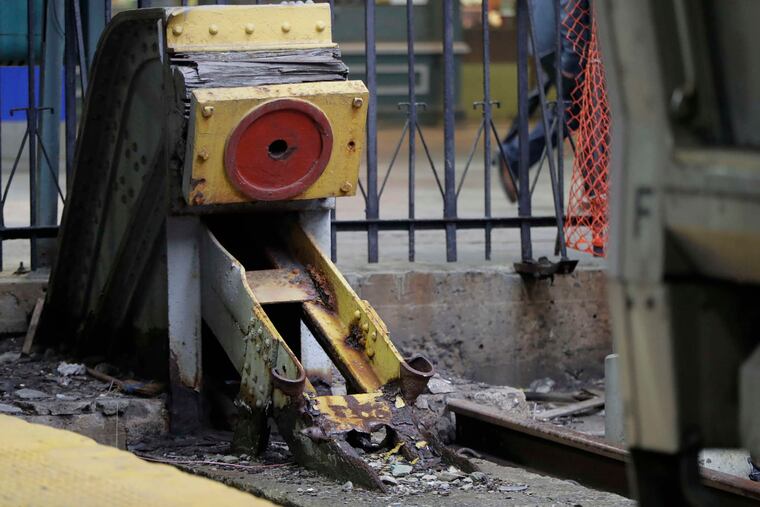Century-old bumper no match for train
HOBOKEN, N.J. - When a NJ Transit commuter train plowed off the end of a track in the Hoboken station in September, killing a woman and injuring more than 100 people, the final thing in its way was a concrete-and-steel bumper that was in place when the station opened in 1907.

HOBOKEN, N.J. - When a NJ Transit commuter train plowed off the end of a track in the Hoboken station in September, killing a woman and injuring more than 100 people, the final thing in its way was a concrete-and-steel bumper that was in place when the station opened in 1907.
Experts say more-modern bumpers, equipped with hydraulic shock absorbers and sled-like friction shoes - like those installed more than 25 years ago at NJ Transit's Atlantic City station - still would not have been able to stop the train, which was traveling at 21 mph, but might have slowed it enough to lessen the damage.
Federal investigators are examining the role the aging bumper played in the Hoboken crash and whether other barriers could have made a difference.
All but one of the tracks in the station, which serves about 15,000 passengers a day, end at the stationary bumpers, just a few feet from the terminal.
NJ Transit is in the process of hiring a consultant for an overall safety review of the terminal, said Steven Santoro, NJ Transit's recently named executive director.
A bumping post with friction shoes would have to be placed farther from the track's end and would effectively reduce the platform length, Santoro said. That, he said, would force NJ Transit to run trains "at least" one car shorter, which could cause overcrowding.
It would "exacerbate an issue that already exists in terms of track lengths," he said. "We would like every platform to be a 10-car platform but can't do that. We are physically constrained by the length of trains we have in our system, and we have to factor that into our analysis."
NJ Transit has embarked on a project to construct three longer platforms at Hoboken as part of post-Hurricane Sandy flood mitigation, but that work isn't expected to be finished until 2020, Santoro said.
A preliminary federal report on the Hoboken crash said the five-car train accelerated from 8 to 21 mph - more than twice the speed limit - as it approached the end of the track Sept. 29, before the emergency brake was engaged in the final second.
Engineer Thomas Gallagher, who later was found to be suffering from sleep apnea, told investigators he had no memory of the train speeding up.
Even the most modern bumpers used in rail stations aren't designed to stop a train going that fast, state and federal rail officials and several experts told AP. Yet it's possible one might have slowed the train enough to lessen the damage.
The train's lead car launched onto the platform, smashed into a wall, and dislodged a canopy and brought concrete, metal and wires raining down on the platform and train. Falling debris killed a woman on the platform. The family of the victim, Fabiola Bittar de Kroon, filed a notice this week of intent to sue.
"Had there been something in place that would absorb some of the kinetic energy of the train, therefore there may have been less damage to the structure, and that piece may not have fallen? That's certainly possible," said Gus Ubaldi, a member of the American Society of Civil Engineers and a former engineering director for the Greater Cleveland Regional Transit Authority.
At impact, bumping posts with friction shoes are "like a car brake: The brakes go on and you're going to slide a little bit, and it grabs the rail," Santoro said. "It's not going to stop immediately, but it's going to slow the train down."